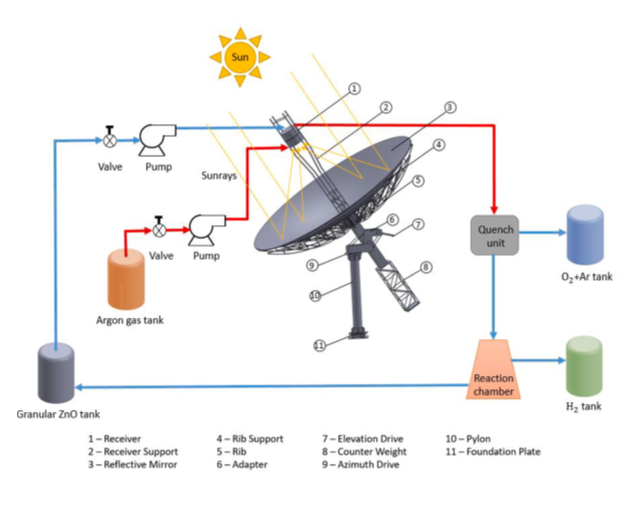
You know what’s weird? We keep talking about the scarcity of energy resources when we have the sun, which is omnipresent all throughout the day!
The sun is the most abundant source of energy. Better still, it is a renewable source of energy. With the effects of climate change taking place all over the world, it is a necessity to utilize all kinds of renewable energy sources available to meet the rising global energy demands as well.
In order to harness the sun’s energy, large areas of sunlight are concentrated on a small area using mirrors or lenses. Such devices used to concentrate sunlight for energy purposes are called concentrated solar power (CSP) technologies.
Of all the CSP technologies, solar parabolic dish is a point-focusing technology that has a high concentration ratio, where the receiver captures the heat from concentrated sunlight to convert it into useful energy.
Solar energy can be used to produce hydrogen as a valuable fuel. Hydrogen has the best energy-to-weight ratio among all energy sources. The use of solar energy to produce hydrogen would help relieve dependency on fossil fuels, which currently accounts for nearly 98 percent of the world’s hydrogen demand. Further, green hydrogen produced from renewable energy is the more sustainable and cleaner type.
In order to produce hydrogen through solar energy means, a process known as the solar thermochemical cycle, which uses volatile metal oxides, is one of the emerging clean hydrogen production techniques. Zinc oxide/zinc two-step water-splitting thermochemical cycle is used to produce hydrogen. Zinc oxide is reduced in the first step, then it is oxidized by steam to generate hydrogen.
The solar thermochemical cycle is responsible for converting solar energy to chemical fuel. The distribution of the concentrated heat flux and temperature on the receiver is crucial to decide solar-to-fuel conversion efficiency. Thus, it is necessary to have the optimum configuration of a solar parabolic dish collector (PDC) to provide efficient thermal energy.
A schematic diagram of a solar parabolic dish-cavity receiver system for thermochemical hydrogen production is given below:


In this study, the authors Mr. Saurabh Jaywant Mohite and Prof. K. S. Reddy from the Heat Transfer and Thermal Power Laboratory, Department of Mechanical Engineering, Indian Institute of Technology Madras, Chennai, India, have done an optical and thermal analysis to determine the optimum configuration of PDC, which produces the required heat flux for the zinc oxide dissociation with a suitable heat flux distribution on the aperture of the thermochemical reactor.
The numerical modelling of the 3D solar thermochemical reactor is done for a non-uniform heat flux extracted from optical simulations.
This paper also implemented an artificial neural network (ANN) for the optical analysis. Few researchers have utilized ANN with CSP technologies. It is faster and more efficient than the SolTrace software that is usually used. ANN was used to predict the heat flux and uniformity factor values of PDC.
Several performance metrices such as the correlation coefficient, root mean square error, etc. were determined while knowing the input variables such as receiver diameter, dish diameter, rim angle etc. for optimum configuration of PDC.
Dr. B. Premachandran from the Department of Mechanical Engineering, Indian Institute of Technology Delhi, New Delhi, India, gave his analysis of this study and confirmed its importance with the following comments: “Hydrogen is considered as the future energy source for various applications including transportation to limit global warming. Even though many well-established hydrogen production methods are available, production of hydrogen without polluting environment directly or indirectly is the main focus nowadays. Hence, solar energy based hydrogen generation becomes very attractive. In solar energy based hydrogen production, parabolic dish collector is preferred as it can support very high temperature operation in the thermochemical reactor. In this paper, Zinc oxide (ZnO) based solar thermochemical cycle is investigated for clean hydrogen production using parabolic dish collector. For better performance hydrogen production, optimization of solar collector and receiver configuration is important and extremely challenging. In this paper artificial neural network is used for optimization dish diameter, rim angle and the distance of the receiver diameter from the local point. Through this study the important aspects of dissociation of Zinc oxide and the maximum mass fraction of zinc and oxygen at the end of dissociating is analyzed to understand the energy conversion efficiency. Reading this paper will provide an overview of solar energy based hydrogen production.”
Article by Akshay Anantharaman
Click here for the original link to the paper









